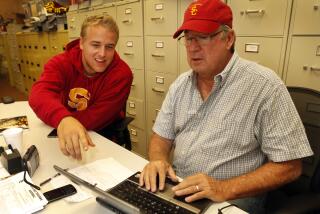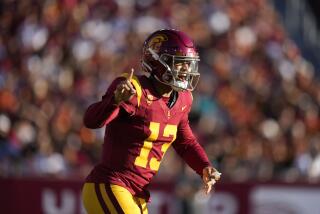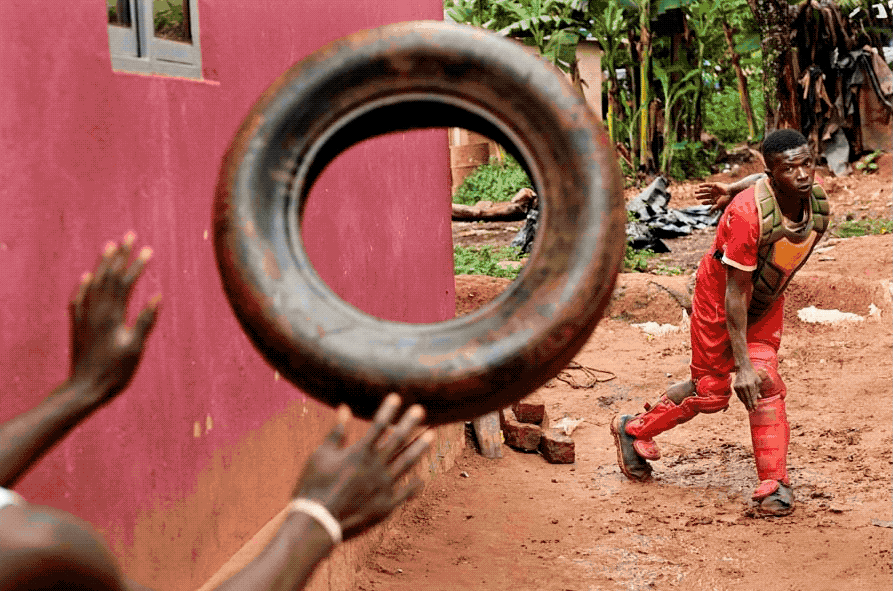Simms Views Job From New Perspective
- Share via
MADISON, N.J. — Phil Simms winces as the pain and frustration of 1983 wash over him again. He and Scott Brunner competed for the New York Giants’ starting quarterback job that year in training camp. Simms had missed the previous season with a knee injury and never shook off the rust. Rookie Coach Bill Parcells eventually chose Brunner and it almost cost him his job when the team went 3-12-1.
“Every day I was always on edge,” Simms said recently. “Always. Constantly. Now, I’m not like that. My approach to this one is 100 percent different.”
Technically, Simms is in another battle for the starting job, this time with Jeff Hostetler, who led the Giants to victory in Super Bowl XXV in January while Simms watched from the sideline, propped up by a pair of crutches. Rookie Coach Ray Handley isn’t likely to make the same mistake Parcells did. He knows Simms has weathered 143 starts in 12 seasons in a Giants’ uniform; Hostetler has seven starts in seven seasons.
“Relaxed?” Simms asked after another sultry day at Fairleigh Dickinson University. “Tired. I’m real tired. Four weeks of sleeping in some little girl’s (dormitory) bed is the hardest thing about camp. It always is. But mentally it’s a lot easier.
“Now you’ve got to take into account what happened the last few years. In 1983, I didn’t have much to look back on.”
Since then, Simms has achieved virtually everything a quarterback lusts for: two Super Bowl rings, a Super Bowl Most Valuable Player award, a Pro Bowl MVP and 15 all-time team passing records.
He is 35 now, and the fury that produced those glories has ebbed some, if only a little. He has, for the first time, something even more valuable than all that glitter in his trophy case. He has peace of mind.
“Was I insecure?” Simms asked. “Oh, sure. Most of my life everything I’ve done has been criticized. I think sometimes that if I didn’t devote as much time to it I probably wouldn’t have succeeded.”
Simms grew up in Louisville, Ky., and developed a ruthless worth ethic out of self-defense. Listen to him put his career in perspective:
“It’s not a case of what I’ve accomplished,” Simms said, “it’s the effort I put into it.
“You know, you are where you come from. I guess I’m still sort of the same. I don’t think mellowed is the word, but I’ve calmed down a little, I guess.”
On and off the field, and it’s made him a better quarterback and a better person, too.
The Giants opened the 1990 season with 10 consecutive victories and Simms was artful. He proved that, even at 34, when most quarterbacks have been carried from the field, the old dog could still learn a few tricks of survival. He finally figured out, contrary to his combative nature, that there were times when giving in didn’t mean giving up.
In the old days he would find his receivers covered and drift out into the flat and wait for something to happen. “Of course,” he said, “it never would. I’d get sacked or throw an interception.
“Yeah, I give up on plays sooner than I have in the past. I hate to say I never played smart before, but I think it’s a little change in belief. Now I look here, there -- bing, bing -- and if it’s not there I throw it away.”
And then Simms suffered a broken foot in Game 14 and the best statistical season of his career was over. Hostetler won all five of the Giants’ remaining games, including the last two against San Francisco and Buffalo. Simms tried hard to smile through the agony, but at the Super Bowl he conceded, “It’s killing me. I mean, you play your whole life to get here and then you can’t play.”
But instead of congealing into bitterness, Simms’ anguish forced him, for the first time, to confront the future.
“I have the classic athlete’s mindset,” Simms said. “I never had time to focus on anything but what was in front of me -- football. In the off-season, at home the whole time, I decided that I had to approach things a little differently.”
He couldn’t play golf with his bad foot, so he spent more time with his wife Diana and kids -- Christopher, Matthew and Deirdre -- at home in New Jersey and at their Florida vacation home. And he liked it. After a decade of refusing prospective television producers, he finally agreed to do a show with his name on it, even though it will basically ruin his only day off during the season. He began to visualize himself as an NFL assistant coach.
Growing up in Kentucky, he never dared to dream of such things. Money was tight, and there were nine children to feed and clothe. You wore your sneakers until the bottoms dropped out. New toys? Simms remembers a bicycle and a baseball glove as the only things his alone.
At age 7, when he began second grade, he rose, grumpy, every morning at 5 to deliver the Louisville Courier-Journal. The ink made his hands stink. For nine years he didn’t sleep in for a single morning. Not one.
Football and baseall were a chubby little boy’s way of escaping from the world. He never made much headway against his older brothers, but when he competed against other kids his age, well ...
“Sports was something of my own,” Simms said. “I had a little more control of it. And I was a different person.”
Playing sports, he was more confident, more outgoing. He could tell people to do things and not feel self-conscious. At home, no one ever listened. Out of uniform Simms was timid and shy.
He was a quarterback and a pitcher at Southern High School in Louisville and he accepted a football scholarship to Morehead State University. He played four seasons and set all kinds of records. As a junior, he seared Tennessee Tech for 370 yards passing and threw four touchdown passes against Marshall. That year, he and Morehead pitcher Walt Terrell pitched in a summer league. Terrell, a major leaguer who once had a 90 mph fastball, says Simms threw harder.
Simms was the first quarterback taken in the 1979 draft, several rounds ahead of Joe Montana. The Giants liked his attitude as much as his physical presence. He was 6 foot 2, 215 pounds and he didn’t seem to mind the contact.
“He waits to the last minute to throw,” wrote Giants’ scout Dick Joyce in his personnel report. “Strong on the long ball, and he takes a pounding.”
There, in one sentence, was Phil Simms. He wanted to win so badly, he often sacrificed his body to complete a single pass.
Simms won six of his first eight starts as a rookie, but that was the highlight of his first five seasons. He missed the last three games of the 1980 season with a separated shoulder; in 1981, another shoulder separation forced him to miss the last five games and the Giants’ first playoff game in 19 years. In 1982, a knee injury in the exhibition season kept him out the entire season and in 1983 -- the nadir in every sense -- Parcells’ decision to start Brunner and a fractured thumb forced him to miss 14 games.
Even from a hospital bed Simms insisted, against mounting evidence, that he was accident-prone, not injury-prone. He was already a regular in the weight room, but during that off-season he slowly built himself a suit of armor.
In the early 1980s, Ray Perkins’ throw-it-deep offense fit perfectly with Simms’ chip-on-the-shoulder personality.
“One reason I didn’t change maybe years ago is, why change something that was successful?” Simms said. “The team was successful, I was successful, the coaches were saying, ‘We like what you’re doing.’
“I thought that way was the only way. We used to look at some of those other offenses that threw it short, like the 49ers. I used to say, ‘They’re doing it wrong.’ It was the old macho thing. ‘Hey, that’s easy. Be a man, do it this way.’ ”
The 1984 training camp presented another challenge to Simms, this one named Jeff Rutledge.
“Hey,” Parcells said, “I don’t want somebody back there who’s going to patter their feet. I want somebody who’s going to stand in there and throw it.”
Simms regained the starting job. “You want to be the quarterback of the New York Giants?” Simms asked. “You do what the coach tells you. You adapt to survive.”
The Giants followed 1983’s 3-12-1 record with a 9-7 record and a berth in the playoffs. Simms completed 286 of 533 passes for 4,044 yards. He was sacked 55 times and threw 18 interceptions, trying to win every game by himself.
In 1986, the Giants finally gave Simms an offense. The Giants won 17 of 19 games, including Super Bowl XXI. Simms completed 22 of 25 passes for 268 yards and three touchdowns in the biggest game of his life. He could have thrown three more incomplete passes and still produced the best percentage in the history of Roman numerals.
In 1988, offensive coordinator Ron Erhardt first began to reign in the passing game. Blitzes were heavier and Simms was taking a beating behind a young offensive line. In 1989, he ripped a pectoral muscle and severely sprained his right ankle. Against the 49ers that season he threw for 326 yards -- off the wrong foot.
Before the 1990 season, Erhardt sat Simms down and said, “You want to play or get hit?”
Simms nodded. “You’re right,” he said, fully understanding the consequences of his answer. The metamorphosis of team and personal philosophy was almost complete.
“Now,” he says, “I don’t try to win them by myself all the time.”
More to Read
Go beyond the scoreboard
Get the latest on L.A.'s teams in the daily Sports Report newsletter.
You may occasionally receive promotional content from the Los Angeles Times.










